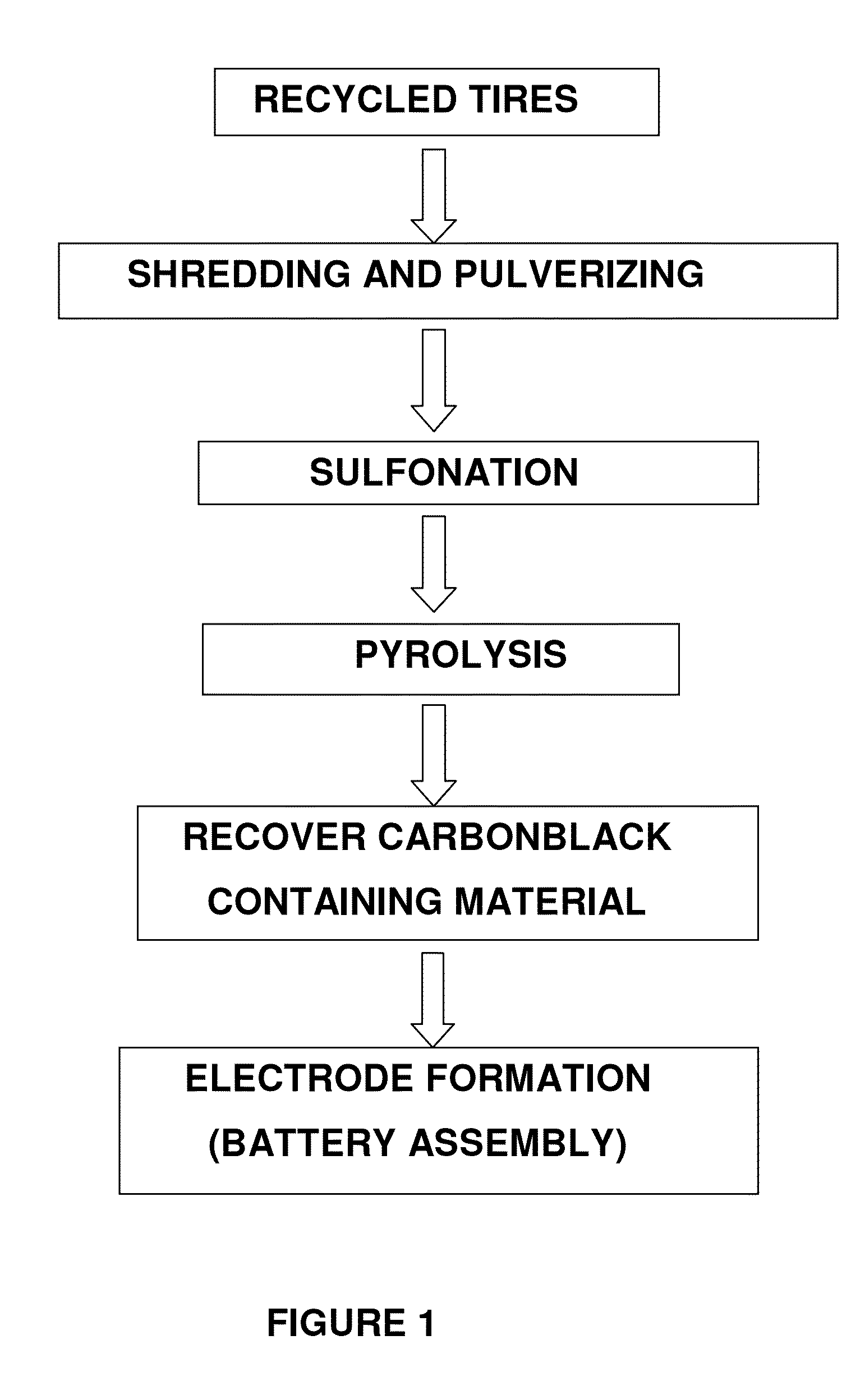Pyrolytic carbon black composite and method of making the same
a carbon black composite and carbon black technology, applied in the direction of cell components, conductors, electrochemical generators, etc., can solve the problem that products are not necessarily good reinforcing fillers for new rubber formulations, and achieve the effect of increasing the density of average pore size of carbon black products between 1 and 20 nm
- Summary
- Abstract
- Description
- Claims
- Application Information
AI Technical Summary
Benefits of technology
Problems solved by technology
Method used
Image
Examples
example 1
[0041]Tire rubber powder of 80-120 μm size range consisting of polymer mixture of natural rubber, butadiene rubber, and styrene-butadiene rubber (45%), carbon black (33%), inorganic filler and vulcanization activator (10%) and residual extractable and volatile materials with specific gravity of 1.15 g / cc was used for the pyrolytic recovery of carbon black. The powder rubber sample was heated in a tubular furnace under nitrogen atmosphere at 1000° C. The temperature of the furnace was raised from room temperature to 1000° C. by heating it at 10° C. / min and when it reached at 1000° C. it was held at that temperature for 15 minutes. The furnace was cooled to room temperature and the carbon residue was collected. The sample is termed as control carbon (Sample #1). The carbon black yield was 33%.
example 2
[0042]Tire rubber powder of 80-120 μm size range consisting of polymer mixture of natural rubber, butadiene rubber, and styrene-butadiene rubber (45%), carbon black (33%), inorganic filler and vulcanization activator (10%) and residual extractable and volatile materials with specific gravity of 1.15 g / cc was used for a chemical pretreatment prior to pyrolysis. The tire rubber powder was treated with fuming sulfuric acid containing 20 wt. % free SO3 gas at 70° C. for 12 h. The tire rubber slurry was filtered on a Buchner funnel with sintered glass disc (fritted glass funnel) using an aspirator followed by washing with distilled water. The washed sulfonated tire rubber cake was then dried at 80° C. for 1 h followed by pyrolysis in tubular furnace under nitrogen atmosphere at 1000° C. The furnace temperature was reached to 1000° C. by heating the furnace from room temperature at 10° C. / min and allowing a soak time of 15 minute at 1000° C. The furnace was allowed to cool to room tempera...
example 3
[0043]Tire rubber powder of 80-120 μm size range consisting of polymer mixture of natural rubber, butadiene rubber, and styrene-butadiene rubber (45%), carbon black (33%), inorganic filler and vulcanization activator (10%) and residual extractable and volatile materials with specific gravity of 1.15 g / cc was used for a chemical pretreatment prior to pyrolysis. The tire rubber powder was treated with fuming sulfuric acid containing 20 wt. % free SO3 gas at 70° C. for 12 h. The tire rubber slurry was filtered on a Buchner funnel with sintered glass disc (fritted glass funnel) using an aspirator followed by washing with distilled water. The washed sulfonated tire rubber cake was then pressed between Teflon sheets under a hot plate inside a compression mold at 110° C. to get rid of moisture and to obtain a thick (2 mm) molded sheet followed by pyrolysis in tubular furnace under nitrogen atmosphere at 1000° C. The furnace temperature reached 1000° C. by heating the furnace from room temp...
PUM
 Login to View More
Login to View More Abstract
Description
Claims
Application Information
 Login to View More
Login to View More - R&D
- Intellectual Property
- Life Sciences
- Materials
- Tech Scout
- Unparalleled Data Quality
- Higher Quality Content
- 60% Fewer Hallucinations
Browse by: Latest US Patents, China's latest patents, Technical Efficacy Thesaurus, Application Domain, Technology Topic, Popular Technical Reports.
© 2025 PatSnap. All rights reserved.Legal|Privacy policy|Modern Slavery Act Transparency Statement|Sitemap|About US| Contact US: help@patsnap.com



